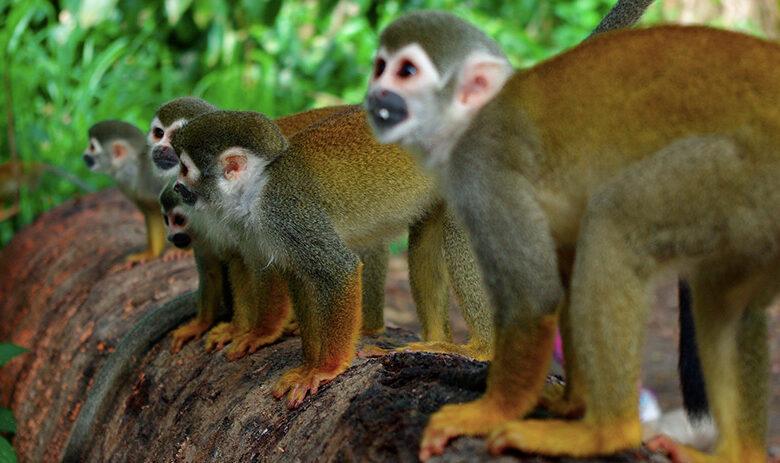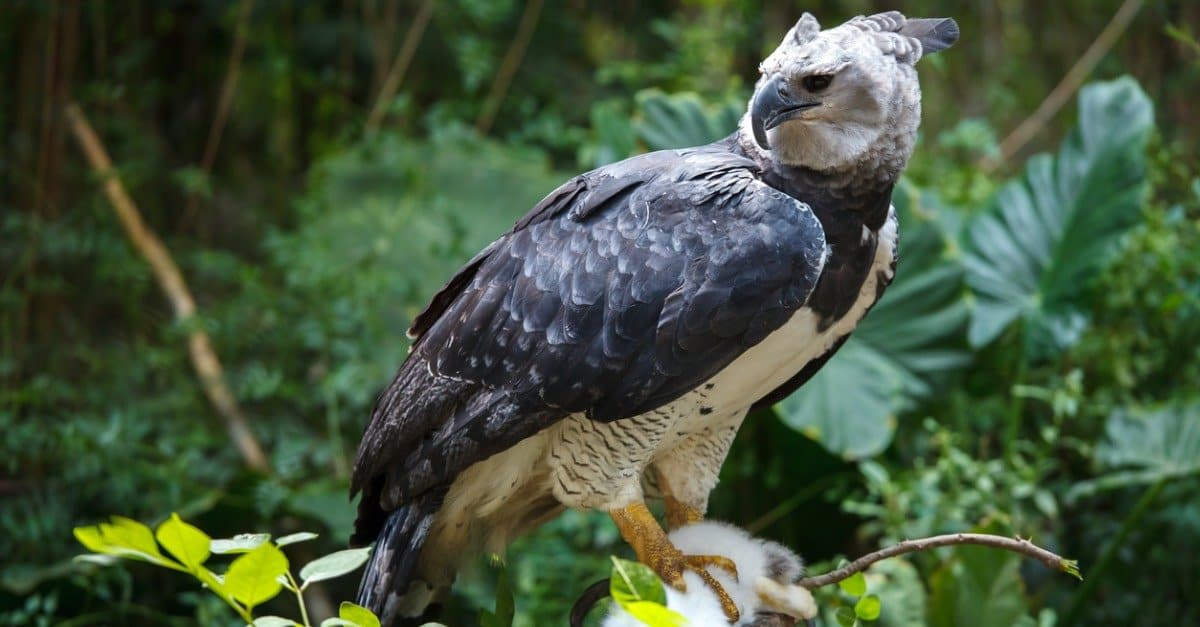
15 Facts About the Amazon Rainforest Animals
15 Facts About the Amazon Rainforest Animals – The Amazon rainforest, often referred to as the “Lungs of the Earth,” is a truly remarkable ecosystem. It stands as one of the most diverse and captivating places on our planet, offering shelter to an astonishing array of species, many of which are found nowhere else on Earth. In this exploration of the Amazon’s wild animal kingdom, we encounter creatures that range from the majestic and fearsome to the tiny yet deadly. These inhabitants of the rainforest play unique roles in the complex web of life that defines this extraordinary environment.15 Facts About the Amazon Rainforest Animals
The 15 Facts About the Amazon Rainforest Animals are:

1. The Harpy Eagle
The Harpy Eagle, the largest raptor in the Amazon and the largest eagle in the Americas, is a formidable predator. With wingspans that can reach an impressive 6.5 feet, they soar through the rainforest canopy, hunting a variety of prey, from sloths to monkeys. Harpies are natural-born hunters, and their talons can grow up to an astounding five inches in length. Unfortunately, deforestation poses a significant threat to these magnificent birds, contributing to their declining populations.
👉 Relocate to Canada Today!
Live, Study and Work in Canada. No Payment is Required! Hurry Now click here to Apply >> Immigrate to CanadaRead Also: Top 15 Bespoke Cake Creations
2. The Blue Morpho Butterfly
The Blue Morpho Butterfly is a striking and ethereal presence in the Amazon’s tropical rainforests. With a remarkably short lifespan of just 115 days, these butterflies engage in an annual migration that takes them through all layers of the rainforest in search of mates. Their vivid blue coloration makes them easy to spot, even from the sky, and adds a touch of enchantment to the rainforest’s lush green canopy.
3. The Potoo
Potoos, enigmatic and nocturnal birds, are masters of camouflage. Their coloring allows them to blend seamlessly with tree bark, making them incredibly difficult to spot. These solitary creatures come alive at night, using their massive eyes and wide mouths to hunt flying insects. When it’s time to raise a family, both parents share the responsibility of incubating the single egg laid each breeding season.NYSC Portal
4. The Pink River Dolphin
The Pink River Dolphin, also known as the Amazon River dolphin or “boto,” is a captivating inhabitant of freshwater ecosystems. Characterized by its rosy hue and pointed rostrum, it undergoes a fascinating transformation from gray to pink as it matures. While they enjoy a varied diet that includes turtles, crabs, shrimp, and various fish species, pink river dolphins face numerous threats, including pollution and contamination of their aquatic habitats.
Read Also: 15 Best Streaming Services in Nigeria
5. The Glass Frog
Glass Frogs are small amphibians with an astonishing feature: their translucent bellies, which allow us to see their internal organs. These frogs are typically found in the humid forests of Central and South America, captivating observers with their see-through skin and vibrant green dorsal sides.Romantic love message
6. The Black Caiman
The Black Caiman, a close relative of the American alligator, is a formidable predator in the Amazon’s waterways. Some individuals reach lengths of up to 13 feet and are known to be aggressive, especially when defending their territory or hunting for prey. With their powerful jaws designed for clamping and gripping, they are patient hunters, waiting for their prey to drown before consuming it whole.
7. The Capybara
The Capybara, the world’s largest rodent, is a gentle giant of the rainforest. This herbivorous creature depends on water for its survival, not only as a source of sustenance but also for protection from predators. Despite their large size, capybaras are excellent swimmers and can hold their breath for extended periods when evading danger.Good morning My Love Message
👉 Relocate to Canada Today!
Live, Study and Work in Canada. No Payment is Required! Hurry Now click here to Apply >> Immigrate to Canada8. The Giant River Otter
The Giant River Otter stands out among its smaller otter cousins due to its size, with some individuals reaching up to six feet in length and boasting a distinctive hairy nose. As stealthy swimmers, they outcompete even apex predators like jaguars and black caimans. Their densely furred snouts set them apart from other otters, making them a unique and endearing presence in Amazonian waters.
Read Also: Top 15 Most Influential Guitarists of All Time
9. The Jesus Lizard
The Jesus Lizard, scientifically known as a basilisk, is aptly named for its remarkable ability to run on the surface of water. These creatures live near water bodies, utilizing their unique skill to evade predators. While they may seem unassuming, they face threats from birds of prey, snakes, and certain fish species.
10. The Spider Monkey
Spider Monkeys are agile primates with prehensile tails that serve as a fifth limb, allowing them to traverse the treetops with ease. Living in social groups, they are wary of humans due to hunting pressures. They possess the remarkable ability to break tree branches to defend themselves, highlighting their resourcefulness and adaptability.Information guide Nigeria
11. Red-Bellied Piranhas
Piranhas, infamous for their reputation as ruthless predators, are often misunderstood. In reality, they typically keep to themselves and only become aggressive during feeding frenzies. Human encounters with these fish rarely lead to the gruesome attacks depicted in popular media.
12. The Matamata Turtle
The Matamata Turtle, with its distinctive ridged carapace and bumpy skin, is a captivating aquatic reptile. Found in South America’s river basins, it prefers slow-moving, shallow waters. Its unique appearance and behavior make it a fascinating addition to the Amazon’s aquatic life.JAMB portal
Read Also: 15 Best Hair Growth Products in Nigeria
13. Peanut Head Bug
The Peanut Head Bug, named for its head’s resemblance to an unshelled peanut, employs ingenious defensive mechanisms. It may release a skunk-like spray or showcase large red and black spots on its wings to deter predators. This tiny creature demonstrates that even the smallest inhabitants of the rainforest have remarkable adaptations.
14. The Anaconda
The Amazonian Anaconda, a member of the boa constrictor family, is one of the rainforest’s most formidable creatures. Although non-venomous, it possesses deadly hunting skills, suffocating and constricting its prey before swallowing it whole. This apex predator occupies the top tier of the Amazonian food chain and can go without eating for months after a large meal.
15. The Poison Dart Frog
The Poison Dart Frog, while tiny in size, is incredibly deadly. These vibrant frogs possess aposematic coloration, warning potential predators of their toxicity. Interestingly, only those raised in captivity lack poison, suggesting that they assimilate it from their diet of plants and insects in the wild.
Read Also: 15 Amazing Health Benefits of Drinking Triphala Juice
Conclusion
The Amazon rainforest’s incredible biodiversity is a testament to the wonders of evolution and adaptation. Each of these 15 remarkable species plays a crucial role in the delicate balance of this complex ecosystem. From the mighty Harpy Eagle to the minuscule Poison Dart Frog, they all contribute to the Amazon’s unparalleled richness and serve as a reminder of the urgent need for conservation efforts to protect this invaluable natural treasure.
Check JAMB Result
Check and Confirm: How much is Dollar to Naira






